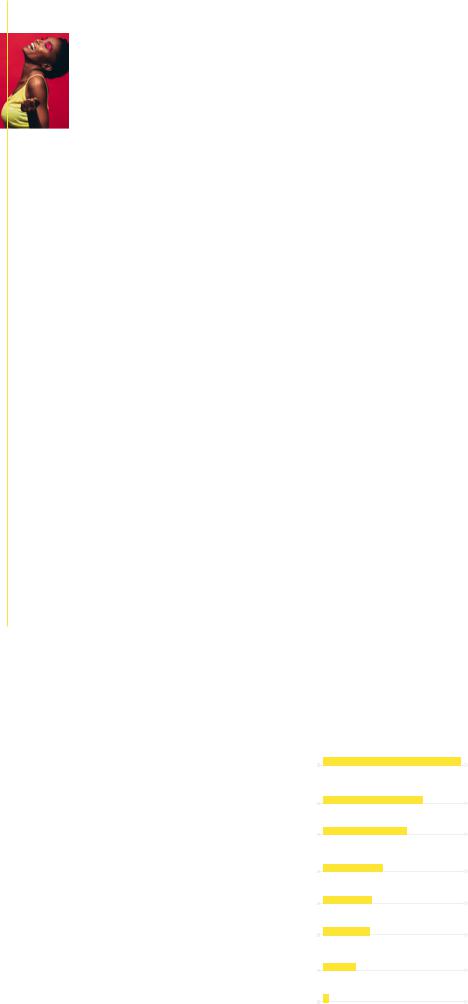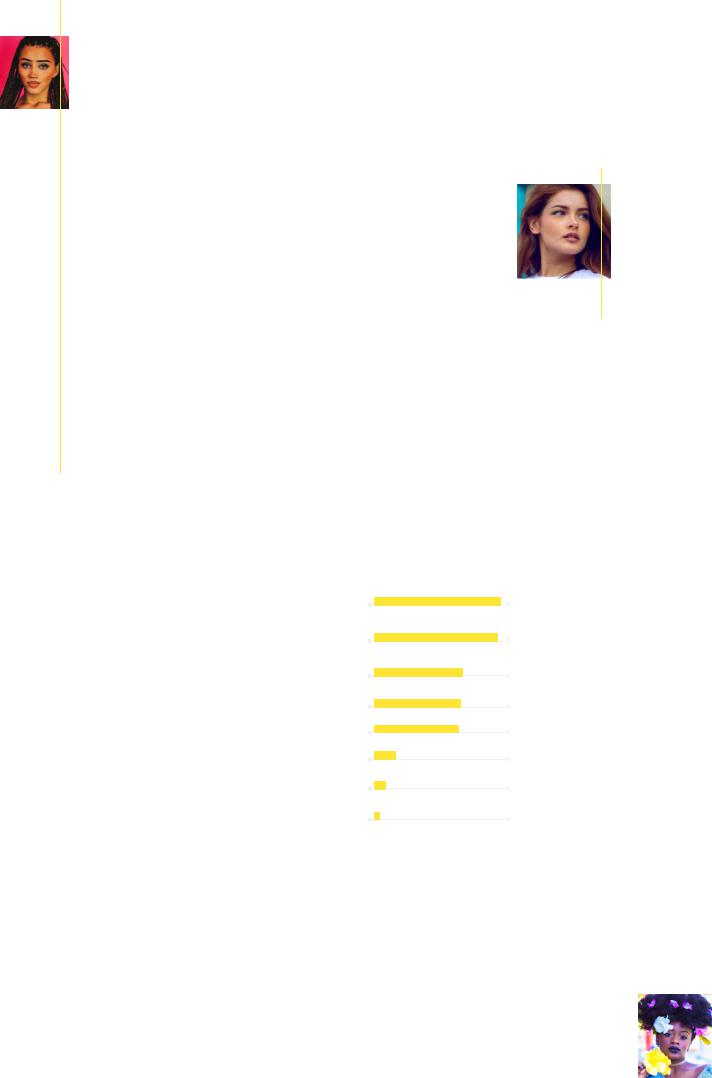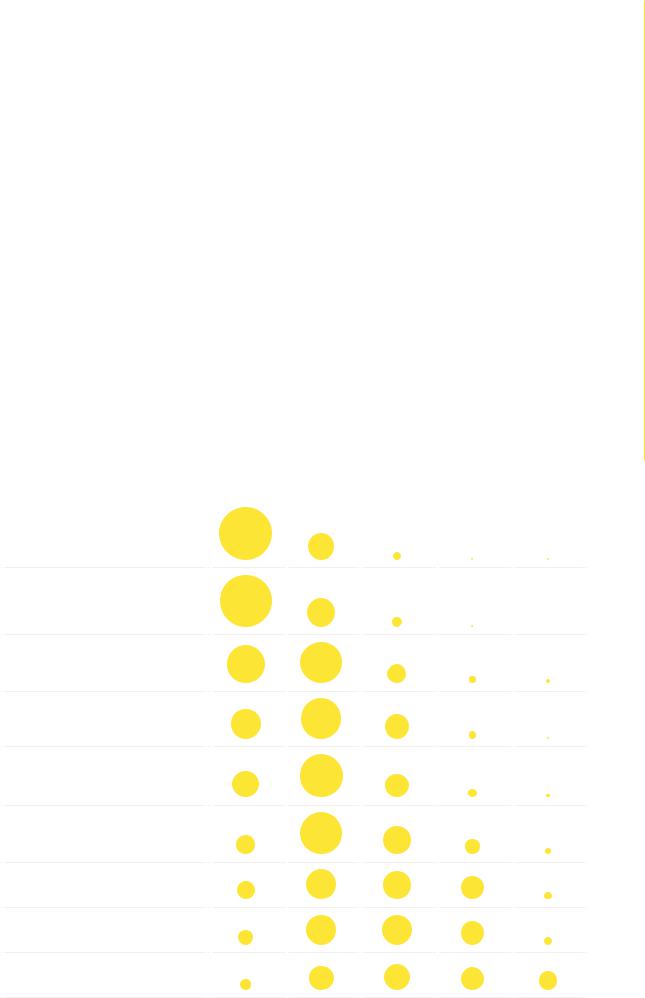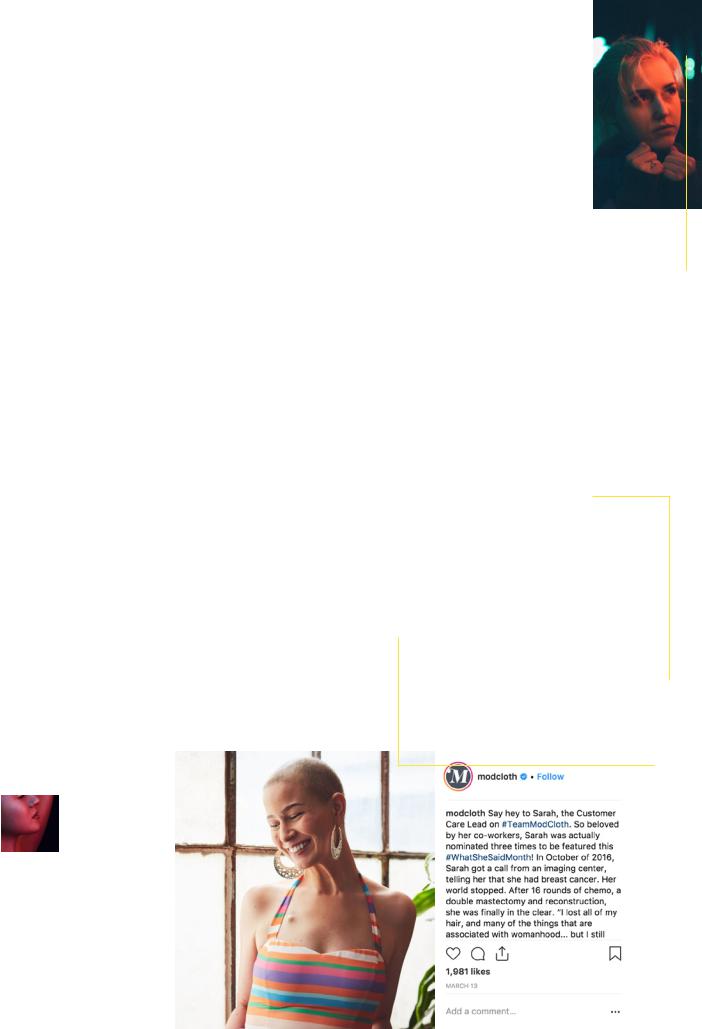
Influncer_Marketing_2020_watermark
.pdf
vk.com/id446425943
Digital influencers have swayed purchase decisions for the majority of millennials
61% of consumers, aged 18 to 34, have at some point been swayed in their decision-making by digital influencers, the consumer survey finds (see Fig. 2 below). Interestingly, US consumers (71%) are more likely to say they have been influenced than UK respondents (51%).
61% 
 39%
39%
Figure 2
Have social media influencers in some way ever influenced your consumer decisions?
Yes
No
11

vk.com/id446425943
How young people perceive digital influence is critical, and as a result, more than half of industry respondents (56%) say the digital-born generation of customers is proving the biggest driver of change (see Fig. 3).
Bexy Cameron, Head of Insight at Amplify, recently published Young Blood 2, a comprehensive study into modern British youth culture that looked extensively at how young people aged 18-30 perceive influencer culture, and how attitudes have shifted since 2016 when the first phase of research was conducted.02 Above all, it unearthed the potential beginnings of a backlash against influencer culture, with the concept of ‘influence’ being notably less popular than it was a couple of years ago. The report reads: “Our young audience see themselves as influential – 62% feel they can influence their peers, which is up from 2016 – but they don’t want to be called influencers as this is now a real job and one that is open season for criticism. Only 18% see themselves as influencers on social media. 41% do not want to be more influential on social (with 26% not having an opinion either way).”
Figure 3
What has been the biggest driver of change?
Changing expectations from a rising generation of digitalborn customers who prefer more relatable, authentic influencers to celebrity with mass appeal
More budget allocated to influencer marketing
Better data and metrics at hand to better inform the influencer identification process
More choice and better representation of influencers across all tiers
A level of consumer distrust towards media
Better integration between online and offline strategy
Our improved ability to quantify the
ROI of influencer marketing
Other
Cameron explains that young people have come to consider the role of ‘influencer’ as a job which is hard graft, very competitive and more commercial than it ever used to be. They have also seen influencers get it wrong too often and be publicly ridiculed for their mistake; overall the novelty of having ‘influence’ has worn off, and the digital-born generation is now more passionate about other things, such as the environment.
According to Cameron, young people have begun to reject the way that influencer marketing has been done over the past five years, and their appetites to be influenced has clearly dropped. “There are nine different types of influence but with influencer schemes and endorsements as an industry we have always looked at something that is very easy to quantify, which is reach,” Cameron explains. “Reach is only one of the types of influence and we should instead be looking at things like does the individual have relevance, do they have authority on a particular subject, how do they treat their audience, is there some natural affinity, etc.”
56%
42%
36%
27%
23%
22%
17%
7%
12

vk.com/id446425943
As a result, 59% of industry respondents say the purpose influencer marketing serves for their business has changed over the past 12 months.
Natasha Hulme, Senior Strategist at Beauty SEEN, says she has observed a significant shift in brand perceptions towards influencer marketing over the last year. “Expertise and a ‘niche’ are becoming increasingly important, as is having an interest or passion in a relevant cultural-territory for the brand or campaign. It might be that we’re looking for people with a philanthropic cause to support, or an advocate for a multi-hyphenate lifestyle, or someone who’s passionate about being an entrepreneur or perhaps someone with a side-stream in street art. It’s increasingly important for our brands to have purpose and be a part of interesting conversations, so more and more we’re looking for influencers with something extra.”
Figure 4
Has the purpose influencer marketing serves for your business changed in the last 12 months?
|
44% |
|
|
|
|
|
32% |
|
|
15% |
|
|
|
|
|
|
|
9% |
|
Changed |
Changed |
Remained |
Not |
|
Significantly |
Slightly |
the same |
changed |
|
|
|
|
at all |
13 |

vk.com/id446425943 |
|
E UD Y |
CONVERSE’S |
AS ST |
‘YOUNG |
C |
AND LACED’ |
|
|
PROGRAMME
INVESTS
IN A NICHE
OF YOUTH
CULTURE
CHA LLENGE
Converse, the 100-year-old streetwear brand, needed to keep relevant to a youth audience. It was performing well among certain demographics, but to remain the brand of choice for 16-25-year- old males particularly it wanted to add the urban youth audience to its roster. The challenge was presented to brand experience agency Amplify, but as Bexy Cameron, Head of Insight, shares:
“When you start working with subcultures especially, you need to be very careful about how you do it, and how long you do it for, to make sure there is a level of authenticity. You need to enter it with a certain mindset which is, ‘what can we give to this subculture?’ rather than ‘what can we take from it?”
STRA
TEGY
Converse embarked on an influencer strategy programme, called ‘Young and Laced’, through which they signed up a group of boys aged 16-
20 and supported them for a year-long period.
Converse chose creative boys from urban communities, who represented exciting, young and local talent, and gave them bursaries and challenges. The campaign wasn’t consumer facing to begin with as above all Converse wanted to understand more about the audience and select the most appropriate talent to work with. They also wanted to give the boys what they needed which was a platform and funding to get themselves going. “These guys were brilliant, but they were ordinary, and they only had 800 followers each. But the point wasn’t reach, it was depth, and in a grassroots way so that we were giving back to a community,” explains Cameron.
|
OUT |
|
COME |
|
The initial programme lasted for a year and by the |
|
end of it the talent had become genuine brand |
|
ambassadors for Converse, truly loving and |
|
endorsing the brand. They were given platforms |
|
to talk about their work, artists to collaborate |
|
with, and mentors to help with everything from |
|
developing creative concepts, to media and PR, |
|
to ensure their work was accessible to the largest |
|
audience possible. “Four years later the boys still |
|
really care about the brand, and some are huge |
|
influencers now,” shares Cameron. “And when |
|
they talk about Converse with a big audience, |
|
the authentic links are there. It was a big risk, |
|
which not all brands would be willing to take, but |
|
it provided an important lesson in the experiences |
|
and emotional connections that a brand can give to |
14 |
influencers, which they couldn’t get anywhere else.” |

vk.com/id446425943
KEY
TRENDS
Attention shifts to micro-influencers
For quite some time it seemed like an influencer’s total following and reach was the most important thing, but the tide is turning, and experts interviewed for this report concurred that brands are beginning to focus on other areas of influence, and particularly the quality of interaction between a talent and their following along with their audience demographics.
As a direct consequence, brands are shifting their attention from top-tier talent to those demonstrating higher levels of quality engagement, and micro-influencers very often fit the bill. They tend to have niche followings who they are deeply connected with, and this can be well suited to a brand who is looking to target a specific audience. As Joseph Harper, Social Media Manager, UK & Ireland, at Kellogg’s, puts it: “why would we invest
Figure 5
in a reach of 2.5m people, if only 30% of that was our target UK audience, and over 50% were based in Lithuania where the specified product isn’t even available to buy?”
Ella Catliff, Head of Communications at The House of Luxury and Founder of La Petite Anglaise, shares that content created by toptier talent isn’t always the most effective. “Over the past couple of years, I have seen a lot of brands paying a large amount of money to toptier influencers, to essentially all produce the same content for them, with the same hashtag,” she explains. “We need to move past that and influencer collaborations could definitely benefit from being a bit more nuanced and bespoke, and particularly within the luxury sector, and it is time to look at different ways of working.”
As Fig. 5 below reveals, industry respondents say that micro-influencers, or those with less than 100,000 followers, are in highest demand, while top-tier talent boasting a global presence are the least sought after.
After identifying potential talent to work with, which statement best describes who you decide to go with?
65% |
659 |
|
|
|
|
59% |
57% |
57% |
58151% |
|
|
|||
505 |
|
523 |
|
|
|
|
49% |
||
|
|
|
|
|
|
41% |
43% |
43% |
|
|
|
|
|
35%
Male
343
Female
Total
Checks
Niche |
Micro- |
Mid-tier |
Top-tier |
Authoritative |
|
influencers |
influencers |
influencers |
influencers |
(expert |
|
(Example: |
(Under 100,000 |
(100,000 - 1m |
(1m followers) |
representation |
|
organic beauty) |
followers) |
followers) |
with a global |
of an industry |
|
|
|
|
presence |
body, journalist |
|
|
|
|
|
editor etc) |
15 |

vk.com/id446425943
Above all, 56% of marketers questioned say that micro or niche influencers are more cost-effective for them to work with than top tier talent, and 55% also believe they have a better connection with their target audience (see Fig. 6 below).
Sarah Evans, Head of Digital at Bottle PR, shares that “clients are being more tactical with budgets, saying they would prefer to seek out microinfluencers, or ones with a lesser following but who have more cut-through with their audiences and a more engaged community. With celebrity or top-tier talent collaborations, you’re renting their audience for a single post, but for the same price, you could take the time to co-create something of meaning with multiple micro-influencers where the content is more likely to resonate.”
Figure 6
What value have micro/niche/mid-tier influencers brought to your campaigns over top-tier talent?
They are more cost-effective than working with top-tier talent
They have a better connection with our target consumers
The content produced by micro/niche/ mid-tier influencer is more authentic
They help deliver a more targeted message
They have higher engagement than top-tier talent
Increased long-term loyalty
They are yet to deliver more value than top tier influencers
Other
|
One trend that appears to be rising in popularity is |
|
for brands to use A-list talent to front the campaign |
|
and be the disruptor, supported by a group of mid- |
|
tier or micro-influencers. Since micro-influencers |
|
lack the volume of reach as a celebrity or top-tier |
|
talent, some brands have found that they need to |
|
work with a group of micro-influencers in order |
|
achieve scale. Furthermore, due to the lower price |
|
tag of micro-influencers, the overall investment |
|
in a group of such talent can still be lower than |
|
collaborating with one A-list influencer, yet the |
|
enhanced engagement levels mean the overall |
16 |
ROI has the potential to be higher. |
56%
55%
39%
38%
37%
9%
5%
2%

vk.com/id446425943
D Y |
|
The #MANGOGirls campaign, created by |
E |
|
entertainment marketing agency ITB Worldwide |
U |
|
for fashion retailer MANGO, is a good example |
S |
|
|
T |
|
of how a brand can take a tiered influencer |
A |
|
|
|
approach. The campaign’s initial launch three |
|
S |
|
|
C |
|
years ago, for MANGO’s SS16 collection, was |
|
|
|
|
|
fronted by three Top Tier brand ambassadors |
|
|
comprising Kendall Jenner, Karlie Kloss and |
|
|
Lui Wen, who were underpinned by a combined |
|
|
global micro to mid tier-influencer layer of 16 |
|
|
individuals. The influencers were given complete |
|
|
freedom to choose their favourite pieces from |
|
|
the brand’s collection and then share photos of |
|
|
themselves wearing them on Instagram, with |
|
|
all the required hashtags. |
|
|
The campaign, now in its third year, has proven |
|
|
so successful it was written about by British |
|
|
Vogue in a dedicated four-page feature last |
|
|
year. Guillermo Corominas, Chief Client Officer |
|
|
at MANGO, commented within the article: “we’ve |
rejected several girls who have a huge number of followers because they aren’t credible as Mango girls. It’s important to us that their style is admired and feels unique, but they also have to like the brand in order for it to not feel forced.” 03
Suri Singh, ITB Influencer Expert, shared the MANGO Girls campaign has enabled the brand to re-claim its sense of identity, and re-align itself with its desired demographic. “Three years later the hashtag lives on, and the needle has moved substantially for MANGO with other brands looking to replicate the model,” he shares. “By carefully selecting the right type of influencer to work with, we have built loyal influencer relationships who have become true advocates for the brand. Overall, the campaign has had great impact and has continued to grow over time, delivered great engagement rates and importantly has formed an important layer of MANGO’s below the line activity.”
61% of consumers say micro-influencers produce more relatable content
When it comes to thinking about the appeal that micro-influencers hold for consumers, 61% say they believe they produce more relatable content (see Fig. 7 below). A further 43% of consumers also say that the micro-tier is more likely to engage in discussion with them.
It additionally seems particularly value the segment of talent (44%), UK respondents (26%).
that US consumers transparency of this significantly more than
Figure 7
What makes micro/niche/mid-tier social media influencers more appealing?
They produce more relatable content |
|
|
|
|
|
|
|
61% |
|
|
|
|
|
|
|
|
|
||
They engage in their discussions |
|
|
|
|
|
|
43% |
|
|
|
|
|
|
|
|
|
|
||
|
|
|
|
|
|
|
|||
The content produced by micro/niche/mid-tier influencers |
|
|
|
|
|
36% |
|
||
|
|
|
|
|
|
|
|
||
|
|
|
|
|
|
||||
The content produced by micro/niche/mid-tier influencers |
|
|
|
|
|
|
|
36% |
|
is more transparent and authentic and hence more trustworthy |
|
|
|
|
|
|
|||
|
|
|
|
|
|
|
|
||
They are yet to deliver more valuable than top tier influencers |
|
|
|
6% |
|
||||
|
|
||||||||
Other |
|
|
1% |
17 |
|||||
|
|
|
|
|
|
|
|||
|
|
||||||||
|
|
|
|
|
|
|
|
|
|

vk.com/id446425943 |
|
E UD Y |
H&M SPORT |
AS ST |
MAKES |
C |
AMBASSADORS |
|
|
OF NICHE
GLOBAL SPORTS ENTHUSIASTS
CHA LLENGE
Fashion brand H&M wanted to make its first foray into the sport and fitness market, but it was keen to do so in a sensitive and thoughtful way. ITB Worldwide, who work with H&M across their big talent campaigns, below the line activities as well as social media campaigns was tasked with the challenge.
STRA
TEGY
“We needed a strategy that would give H&M Sport a meaningful place in this market, where not only were they aligning themselves with people of influence, but also people who were very much authentic to the world of sport,” Suri Singh, ITB Influencer Expert, explains. “Sport was one of the last sectors to embrace influencer marketing, despite its heritage in celebrity marketing, and H&M was quite right to tap into while it was still an emerging market and do so in a way that wasn’t just momentary.” ITB embarked on an influencer ambassador programme for H&M, utilising four carefully cast micro to mid-tier influencers for a 12-month engagement. “Not only did the campaign need to demonstrate authenticity but to make a mark, it would also be less about numbers and more about longevity and getting across to the influencer’s audience that these people were working with H&M as ambassadors.”
Australian influencer Amanda Bisk was the first ambassador selected: a former elite pole-vaulter, physio and a qualified yoga teacher. “Sport and fitness play a big part in her day-to-day life, both professionally and privately, and that was crucial for the campaign,” shares Singh. “we put together a programme that would engage her over 12 months and include shoot services, throughout which H&M would give her product, and she would be paid a fee for her engagement with the brand.” The concept was to give the influencer ambassadors complete creative freedom so that they could introduce the H&M Sport collection into their daily life naturally and organically. The only requirement was that H&M Sport was tagged in content along with the campaign hashtag. Exclusivity within the sport and leisure sector was however an important requirement, not specific to footwear, to ensure the message wouldn’t be diluted by other competing brands.
OUT
COME
“Three years later Amanda is still an H&M Sport ambassador,” says Singh. Year-on-year H&M Sport have continued its agreement with her, and her audience looks to her as an authority in this space. Her profile has grown to over 200k followers since joining the programme.”
In the second year of the campaign, H&M Sport recruited Tommy Rivers Puzey, a relatively unknown (at the time) runner living in a remote part of Arizona. “Tommy was a micro-influencer but his aesthetic and the content he was producing was incredible. H&M listened to us, and they saw the opportunity. For Tommy it was an opportunity for him to build his profile with one of the world’s biggest high street brands.”
Tommy overdelivered and because of the partnership his reach has now grown to 90.3k followers, and he is now travelling the world with H&M Sport. H&M have continued his contract for year two and are about to embark on year three with Tommy. The programme has also put him on the radar for other brands and he now has a lucrative footwear deal with Ultra, and a coach for Peak Run performance. “He has established a profile without even realising he was a person of influence,” shares Singh.
“Three years ago, measuring engagement was never part of our remit, but as this space has evolved more people have come to understand that it isn’t all about having a large number of followers; engagement is now a key metric that everyone is looking for,” explains Singh. “We are currently in conversation with H&M Sport to discuss its next signings and how we add another layer to continue to elevate this campaign.”
18

vk.com/id446425943
90% of marketers say authenticity is critical to the future of influencer marketing
Influencer marketing evolved out of a growing appetite for authenticity among consumers. At the time there was (and still is) plenty of research to indicate that consumer faith in paid forms of advertising was eroding, and that individuals were instead gravitating towards content created by trusted, likeminded authorities, who lacked a clear commercial objective.
Indeed, within the consumer survey, 79% of respondents say they prefer influencer content over celebrity ads since it tends to offer a better reflection of real life. A further 61% express a preference for influencers who create authentic, engaging content.
However, as influencer marketing has grown and the space has become more deeply saturated with individuals being paid sometimes hefty fees to discuss brands and co-create content with them,
Figure 8
the trust or authenticity factor is in danger of waning once again. Within the consumer survey, 46% say that for them to trust and buy into influencer-led campaigns, it is essential that the content that is authentic and therefore engaging. Consumers are savvy and in tune with how commercialised the influencer space is becoming, which means that branded influencer content is subject to intense scrutiny the moment it goes live.
Brands are fully aware of this danger zone and more than two-thirds (68%) of industry respondents agree that authenticity and transparency is key to influencer marketing success. Furthermore,
90% of industry respondents say that brands need to take authenticity and transparency more seriously, for influencer marketing to be sustainable over the long term (see Fig. 23 below).
To what extent do you agree or disagree with these statements?
Transparency and authenticity is key to influencer marketing success
Working with influencers who have a natural brand affinity and shared ethics with the brand is critical
Generating engagement is more important than reach for an influencer-led campaign
Proving ROI on influencer marketing is essential to our strategy
Influencer content offers better exposure to real life examples of how products look through user generated content
Influencer marketing is enabling the business to truly interact with consumers directly
Influencer marketing provides a better way to build brands at a global scale
Influencer marketing helps to directly drive sales
Influencers are becoming more involved product development
68% |
26% |
4% |
1% |
1% |
65% |
27% |
7% |
1% |
0% |
37% |
43% |
13% |
5% |
2% |
34% |
41% |
19% |
5% |
1% |
29% |
45% |
18% |
6% |
2% |
15% |
43% |
28% |
11% |
3% |
14% |
34% |
31% |
16% |
5% |
10% |
34% |
34% |
18% |
4% |
7% |
28% |
31% |
1823% |
11% |
Strongly |
Somewhat |
Neither Agree |
Somewhat |
Strongly |
Agree |
Agree |
or Disagree |
Disagree |
Disagree |
19

vk.com/id446425943
The rise of a new pool of ‘talent’ in the shape of customers and employees
The experts interviewed for this report stressed the need for due diligence in the selection process, to ensure each influencer collaboration is a credible match for the brand. “If brands are seeing that an influencer is deleting content two weeks after the collaboration, then it really proves that they are choosing the wrong influencers, and the authenticity piece is missing,” says Bexy Cameron, Head of Insight at Amplify. “But if they have got the right person on board they will be proud of that post.”
Sarah Evans, Head of Digital at Bottle PR, believes the pressure to demonstrate authenticity will drive brands to make better use of genuine advocates such as employees and customers – a tried and tested strategy that dates back to the mid-20th century, which a raft of brands within the fashion and beauty brands particularly are now reigniting. “People need to be able to see themselves in the content and be able to relate to the influencer,” Evans explains. “With the next wave of influencer marketing we will see more substance and it will be more thoughtful, adding value for the customer.”
ModCloth
Vintage fashion retailer ModCloth is a good example of a brand who has cast employees in its digital ad campaigns and Instagram feed for several years. It frequently shares photos of its staff modelling its products, so that customers can get a genuine and authentic feel for what the garment will look like ‘in real life’. Alongside this it has its #modclothsquad of brand ambassadors, who represent ‘real’ people of all shapes and sizes.
“It’s an authentic way to connect with our customer,” says Nicole Haase, ModCloth’s VP of Merchandising, in an interview with Glamour magazine. “As merchants, if we don’t believe in the product that we are assorting, then why would we think anyone would buy it?”04
Photo credit: Modcloth
20
